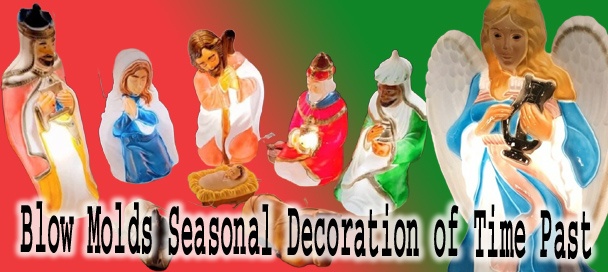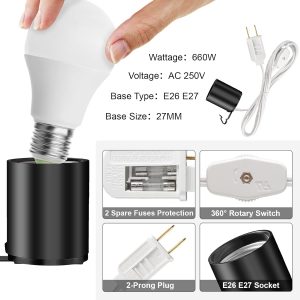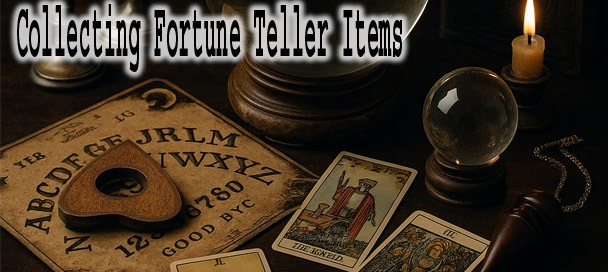⭐ Collecting Blow Molds – Inspiring Look at a Classic Tradition

Vintage Blow Mold Nativity Set Baby Jesus, Mary, and Joseph
Collecting blow molds has grown into a genuine hobby because these pieces offer something both familiar and lasting. What began as simple yard decorations has become a way to preserve a part of seasonal history. Their color, soft illumination, and unmistakable shapes make them easy to appreciate, and that is often what draws people into collecting blow molds in the first place.
Collecting blow molds has become a widely appreciated hobby among vintage decor fans, seasonal decorators, and collectors who enjoy preserving mid-century holiday designs. These hollow figures, once common in yards across America, reflect decades of craftsmanship from companies like Empire, General Foam, and Beco. Their durability, color, and nostalgic glow have made them enduring favorites. This article explores the history, artistry, and modern appeal behind collecting blow molds.
Many collectors remember finding their first piece at a garage sale, flea market, or estate auction. Once it lights up again, the appeal is immediate. As people continue collecting blow molds, they start noticing the differences between manufacturers, from Empire’s bold forms to General Foam’s gentler designs, and recognizing those distinctions becomes part of the satisfaction.
The hobby also fits well for anyone who enjoys practical, hands-on work. These decorations are durable, simple to refresh, and easy to display indoors or outdoors. Collecting blow molds naturally leads to searches for older runs, short-lived designs, and figures made for only one season, which gives the hunt a steady sense of discovery.
The real charm of collecting blow molds is that each figure carries a bit of seasonal history, turning simple plastic decorations into small time capsules of mid-century American holidays.
🕰️ The Origins of Collecting Blow Molds
The origins of collecting blow molds begin with the rise of mid-century plastic manufacturing, when companies first experimented with hollow forms that were sturdy, light, and inexpensive to produce. This shift made large seasonal figures practical for homes that wanted eye-catching displays without heavy materials or fragile finishes. As these early designs appeared in neighborhoods, they shaped an entirely new style of holiday decorating and laid the groundwork for what would later become the broader interest in collecting blow molds.
During the 1960s, manufacturers such as Empire, Beco, and Carolina Enterprises refined their approach, introducing molds with cleaner lines, brighter colors, and more detailed features. Their figures quickly became familiar sights during Christmas and Halloween, creating memories that lasted long after each season ended. For many people who now enjoy collecting blow molds, these childhood impressions explain why certain designs still feel instantly recognizable.
By the 1970s and 1980s, production expanded and competition increased, leading to a wider range of characters, sizes, and themes. General Foam and other makers added their own style, giving collectors a variety of looks to identify and appreciate. These decades also produced many of the pieces that collectors search for today, since shorter production runs and regional availability created natural rarity.
As time moved on and several companies shut down or shifted focus, older pieces became harder to find. That scarcity helped turn a simple decoration into a collectible field of its own. These early decades continue to guide the modern interest in collecting blow molds, since understanding their origins helps collectors trace designs, date figures, and appreciate the evolution of the craft.
🎯 What Makes a Blow Mold Collectible?
A blow mold becomes collectible when its design, age, or maker reflects a specific moment in seasonal decorating. Pieces from companies no longer in production, such as Empire or General Foam, often stand out because they represent styles that cannot be reproduced today. Collecting blow molds naturally centers on these older examples, since their colors, sculpting, and proportions show the character of the era in which they were made.
Rarity also plays a strong role. Some figures were produced for only a single season, while others appeared only in certain regions or through limited catalogs. When collectors discover these short-run designs, demand rises quickly. Collecting blow molds often leads people to seek out unusual variations, alternate paint schemes, or early runs that differ from later versions.
Condition finishes the equation. A piece that still carries its original paint, retains clean lines, and lights properly tends to draw more interest. Collecting blow molds rewards careful preservation, since even common figures become appealing when they survive with minimal wear. This balance of age, scarcity, and condition is what shapes most of the hobby’s values.
Several popular Santa molds from the 1960s reused the same base body with only the head redesigned for different catalog years.
🎨 Design & Art
Collectors often point to design as the heart of the hobby, since the best pieces show a clear artistic identity. Early manufacturers paid close attention to posture, facial expression, and how light would move through the plastic once illuminated. Collecting blow molds naturally highlights these details, because the strongest designs hold their charm even after decades of outdoor use. Subtle sculpting choices, such as how a coat folds or how a smile is shaped, help explain why some figures have become long-standing favorites.
Paint work is another key element. Older blow molds often used bold, hand-applied colors that gave each piece a warm, slightly imperfect character. This style can be seen in classic Santa figures with expressive eyes, snowmen with deep shading, and Halloween characters that rely on crisp contrasts to stand out at night. When collectors talk about the “look” of vintage pieces, they often refer to this blend of sculpted form and painted detail that defined the era.
A few standout designs have become especially sought after. Empire’s choir children and carolers, General Foam’s nativity figures, the Union Don Featherstone penguins, and several mid-century Santas remain high on many wish lists. Their designs have held up because they balance charm and clarity, making them strong centerpieces for both indoor shelves and full outdoor displays. For anyone collecting blow molds, these well-crafted figures show how design and art can lift a simple decoration into a lasting collectible.
👥 Who’s Collecting Blow Molds Today?
The people collecting blow molds today come from a wide range of backgrounds, though many share a desire to preserve pieces that remind them of childhood holidays. Some grew up seeing a glowing Santa or snowman in the yard and now enjoy finding those same figures for their own homes. Others simply appreciate the craftsmanship of older designs and the history behind the companies that made them.
A growing number of collectors are younger homeowners who discovered the hobby through social media groups, vintage resale pages, or neighborhood displays. They enjoy the hunt as much as the nostalgia, and collecting blow molds gives them a way to build seasonal scenes without relying on modern inflatables or more fragile decorations. The shared excitement during holiday seasons keeps these communities active throughout the year.
There are also dedicated hobbyists who focus on repairs, restorations, and identifying rare variations. They help newcomers learn how to clean paint, replace wiring, and date older figures. Their knowledge supports the overall hobby and encourages others to continue collecting blow molds with confidence, keeping these pieces visible and appreciated for another generation.
A few rare Halloween blow molds were produced only for regional hardware stores, making them nearly impossible to identify without original packaging.
6 Set Blow Mold Light Kit Replacement Single Bulb Light Cord

Halloween Christmas Blow Mold Village Craft Indoor Outdoor Decorations Light Kit
About This Item
• Complete Set for Your Needs: Includes six full blow mold replacement light kits. Each set features a 5-foot lamp cord with switch, 27 mm socket compatible with E26/E27 bulbs, and a 3.5-inch base. Every unit is individually packaged for convenience.
• Safe and Convenient Usage: Each cord features a 2-prong plug rated 125V 5A with two included fuses. The built-in switch makes operation easy for indoor or outdoor displays.
• Easy Installation: Insert an E26/E27 bulb, set the socket into its base, place inside the blow mold, and plug in. Always disconnect power while installing.
• Create Your Festive Glow: Ideal for Christmas village pieces, pumpkin blow molds, salt lamps, and medium-base decorative lighting. Supports bulbs up to 250V 660W. LED or incandescent bulbs may be used.
• Versatile Application: The E27 socket offers excellent heat dissipation and durability. Suitable for large outdoor blow molds and indoor craft lighting. Works well as a replacement for restoring vintage blow molds.
📦 How to Store & Maintain Blow Molds
Proper care keeps older pieces looking bright and steady from one season to the next, and anyone collecting blow molds benefits from a simple approach that protects color, wiring, and structure without much effort.
Storage Environment
A clean, dry space is the safest choice. Attics and sheds can work if temperatures stay moderate, but a basement or interior closet is usually better because it avoids warping and fading. Keep each figure upright to prevent dents, and avoid stacking anything on painted areas.
Routine Maintenance
Before storing, wipe each piece with a soft cloth to remove dust and outdoor residue. Check the cord and bulb socket for wear, and replace anything that feels brittle. Light cleaning once or twice a year keeps colors sharp and prevents long-term buildup that can dull the plastic.
Preservation & Restoration
Older figures sometimes need a deeper touch, especially if the paint has faded or a small crack has formed. Basic repairs are simple, but collectors who want a careful, step-by-step guide can follow the full restoration walkthrough here:
https://kilroywashereshop.com/blow-mold-restoration/
Some early blow molds were painted by hand in small batches, meaning no two pieces were ever perfectly identical.
🛍️ Where to Buy, Sell & Trade Blow Molds
Collectors typically begin their search in familiar places such as local thrift shops, flea markets, and seasonal estate sales. These spots remain reliable because older families often kept their decorations for decades, and pieces surface when households begin clearing storage rooms or transitioning collections. The best finds often come from small towns, where decorations were stored indoors and used gently over many seasons.
Online marketplaces have become central to collecting blow molds. Listings appear year-round on auction sites and classified platforms, with the most activity during late summer and early fall. Many collectors watch for local pickup options to avoid high shipping costs, since larger pieces can be awkward to pack. Social groups dedicated to collecting blow molds also host regular “for sale” posts, allowing buyers to compare variations and verify makers before completing a purchase.
Specialty shops and restoration sellers offer another dependable path. Kilroy Was Here in Southwest Iowa occasionally has restored Christmas and Halloween blow molds, and small regional shops often carry similar inventory during holiday months. These sellers take time to repair wiring, clean surfaces, and match older paint styles, which helps collectors secure pieces in display-ready condition.
Trading has also become an important part of the hobby. Many collectors prefer exchanging figures rather than buying outright, especially when searching for harder-to-find designs or seasonal favorites. Trades often happen at swap meets, community yard sales, and private meetups arranged through collector groups. This approach gives both sides a chance to see items firsthand and build trust within the collecting community.
Closing Reflection
Collecting blow molds remains meaningful because these pieces preserve a warm, familiar style of holiday decorating that has nearly disappeared from modern production. Their glow, artwork, and durability continue to connect generations who grew up seeing them on porches and lawns across the country.
Further Reading & Resources
📖Seasonal Blow Molds Gallery
📰 Vintage Blow Molds: The Holiday Décor of Our Childhood

ML Lamp is the owner of Kilroy Was Here. After his 20 years of working in Las Vegas in the entertainment promotions field, Mr. Lamp retired in 2002 from his job to pursue his passion for collectibles. Now as a guest speaker and author he’s living the dream, and sharing his warmth with You.





